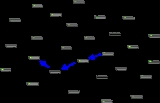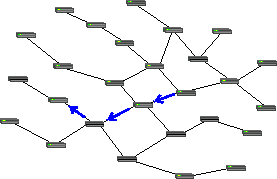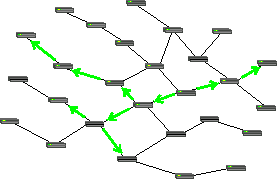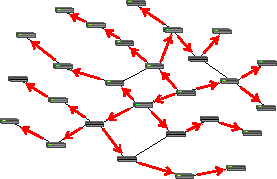
Forwarding
Encyclopedia
Forwarding is the relaying of packets from one network segment
to another by nodes
in a computer network
.


 The simplest forwarding model — unicast
The simplest forwarding model — unicast
ing — involves a packet being relayed from link to link along a chain leading from the packet's source to its destination. However, other forwarding strategies are commonly used. Broadcasting
requires a packet to be duplicated and copies sent on multiple links with the goal of delivering a copy to every device on the network. In practice, broadcast packets are not forwarded everywhere on a network, but only to devices within a broadcast domain
, making broadcast a relative term. Less common than broadcasting, but perhaps of greater utility and theoretical significance, is multicast
ing, where a packet is selectively duplicated and copies delivered to each of a set of recipients.
Networking technologies tend to naturally support certain forwarding models. For example, fiber optics and copper cables run directly from one machine to another form natural unicast media — data transmitted at one end is received by only one machine at the other end. However, as illustrated in the diagrams, nodes can forward packets to create multicast or broadcast distributions from naturally
unicast media. Likewise, traditional Ethernet
(10BASE5
and 10BASE2
, but not the more modern 10BASE-T
) are natural broadcast media — all the nodes are attached to a single long cable and a packet transmitted by one device is seen by every other device attached to the cable. Ethernet
nodes implement unicast by ignoring packets not directly addressed to them. A wireless network
is naturally multicast — all devices within a reception radius of a transmitter can receive its packets. Wireless nodes ignore packets addressed to other devices, but require forwarding to reach nodes outside their reception radius.
At nodes where multiple outgoing links are available, the choice of which, all, or any to use for forwarding a given packet requires a decision making process that, while simple in concept, is
sometimes bewilderingly complex. Since a forwarding decision must be made for every packet handled by a node, the total time required for this can become a major limiting factor in overall network performance. Much of the design effort of high-speed routers and switch
es has been focused on making rapid forwarding decisions for large numbers of packets.
The forwarding decision is generally made using one of two processes: routing
, which uses information encoded in a device's address to infer its location on the network, or bridging
, which makes no assumptions about where addresses are located and depends heavily on broadcasting
to locate unknown addresses. The heavy overhead of broadcasting has led to the dominance of routing
in large networks, particularly the Internet
; bridging is largely relegated to small networks where the overhead of broadcasting is tolerable. However, since large networks are usually composed of many smaller networks linked together, it would be inaccurate to state that bridging has no use on the Internet; rather, its use is localized.
IPT, Intermittent Periodic Transmit, is a proprietary packet-forwarding scheme that is designed to reduce radio interference in the forwarding path of mesh networks. IPT forwarding eliminates packet collisions and therefore enables high throughput in long hop relays, permitting creation of a large scale mesh.
In 2010, hundreds of wireless LAN access points incorporating the technology were installed in the commercial shopping and entertainment complex, Canal City Hakata, resulting in the successful operation of one of the world's largest indoor wireless multi-hop backhauls.
Network segment
A network segment is a portion of a computer network. The nature and extent of a segment depends on the nature of the network and the device or devices used to interconnect end stations.-Ethernet:...
to another by nodes
Node (networking)
In communication networks, a node is a connection point, either a redistribution point or a communication endpoint . The definition of a node depends on the network and protocol layer referred to...
in a computer network
Computer network
A computer network, often simply referred to as a network, is a collection of hardware components and computers interconnected by communication channels that allow sharing of resources and information....
.



Unicast
right|200pxIn computer networking, unicast transmission is the sending of messages to a single network destination identified by a unique address.-Addressing methodologies:...
ing — involves a packet being relayed from link to link along a chain leading from the packet's source to its destination. However, other forwarding strategies are commonly used. Broadcasting
Broadcasting (networks)
right|250pxIn telecommunication and information theory, broadcasting refers to a method of transferring a message to all recipients simultaneously...
requires a packet to be duplicated and copies sent on multiple links with the goal of delivering a copy to every device on the network. In practice, broadcast packets are not forwarded everywhere on a network, but only to devices within a broadcast domain
Broadcast domain
A broadcast domain is a logical division of a computer network, in which all nodes can reach each other by broadcast at the data link layer. A broadcast domain can be within the same LAN segment or it can be bridged to other LAN segments....
, making broadcast a relative term. Less common than broadcasting, but perhaps of greater utility and theoretical significance, is multicast
Multicast
In computer networking, multicast is the delivery of a message or information to a group of destination computers simultaneously in a single transmission from the source creating copies automatically in other network elements, such as routers, only when the topology of the network requires...
ing, where a packet is selectively duplicated and copies delivered to each of a set of recipients.
Networking technologies tend to naturally support certain forwarding models. For example, fiber optics and copper cables run directly from one machine to another form natural unicast media — data transmitted at one end is received by only one machine at the other end. However, as illustrated in the diagrams, nodes can forward packets to create multicast or broadcast distributions from naturally
unicast media. Likewise, traditional Ethernet
Ethernet
Ethernet is a family of computer networking technologies for local area networks commercially introduced in 1980. Standardized in IEEE 802.3, Ethernet has largely replaced competing wired LAN technologies....
(10BASE5
10BASE5
10BASE5 was the original commercially available variant of Ethernet.For its physical layer it used cable similar to RG-8/U coaxial cable but with extra braided shielding. This is a stiff, diameter cable with an impedance of 50 ohms , a solid center conductor, a foam insulating filler, a shielding...
and 10BASE2
10BASE2
10BASE2 is a variant of Ethernet that uses thin coaxial cable , terminated with BNC connectors...
, but not the more modern 10BASE-T
10BASE-T
Ethernet over twisted pair technologies use twisted-pair cables for the physical layer of an Ethernet computer network. Other Ethernet cable standards employ coaxial cable or optical fiber. Early versions developed in the 1980s included StarLAN followed by 10BASE-T. By the 1990s, fast, inexpensive...
) are natural broadcast media — all the nodes are attached to a single long cable and a packet transmitted by one device is seen by every other device attached to the cable. Ethernet
nodes implement unicast by ignoring packets not directly addressed to them. A wireless network
Wireless network
Wireless network refers to any type of computer network that is not connected by cables of any kind. It is a method by which homes, telecommunications networks and enterprise installations avoid the costly process of introducing cables into a building, or as a connection between various equipment...
is naturally multicast — all devices within a reception radius of a transmitter can receive its packets. Wireless nodes ignore packets addressed to other devices, but require forwarding to reach nodes outside their reception radius.
At nodes where multiple outgoing links are available, the choice of which, all, or any to use for forwarding a given packet requires a decision making process that, while simple in concept, is
sometimes bewilderingly complex. Since a forwarding decision must be made for every packet handled by a node, the total time required for this can become a major limiting factor in overall network performance. Much of the design effort of high-speed routers and switch
Network switch
A network switch or switching hub is a computer networking device that connects network segments.The term commonly refers to a multi-port network bridge that processes and routes data at the data link layer of the OSI model...
es has been focused on making rapid forwarding decisions for large numbers of packets.
The forwarding decision is generally made using one of two processes: routing
Routing
Routing is the process of selecting paths in a network along which to send network traffic. Routing is performed for many kinds of networks, including the telephone network , electronic data networks , and transportation networks...
, which uses information encoded in a device's address to infer its location on the network, or bridging
Bridging (networking)
Bridging is a forwarding technique used in packet-switched computer networks. Unlike routing, bridging makes no assumptions about where in a network a particular address is located. Instead, it depends on flooding and examination of source addresses in received packet headers to locate unknown...
, which makes no assumptions about where addresses are located and depends heavily on broadcasting
Broadcasting (networks)
right|250pxIn telecommunication and information theory, broadcasting refers to a method of transferring a message to all recipients simultaneously...
to locate unknown addresses. The heavy overhead of broadcasting has led to the dominance of routing
Routing
Routing is the process of selecting paths in a network along which to send network traffic. Routing is performed for many kinds of networks, including the telephone network , electronic data networks , and transportation networks...
in large networks, particularly the Internet
Internet
The Internet is a global system of interconnected computer networks that use the standard Internet protocol suite to serve billions of users worldwide...
; bridging is largely relegated to small networks where the overhead of broadcasting is tolerable. However, since large networks are usually composed of many smaller networks linked together, it would be inaccurate to state that bridging has no use on the Internet; rather, its use is localized.
Advances in Packet Forwarding
The Mimo-Mesh Project of Kyushu University based in Fukuoka City, Fukuoka Prefecture, Japan, has developed and put into use new packet forwarding technology for building wide-area wireless infrastructure.IPT, Intermittent Periodic Transmit, is a proprietary packet-forwarding scheme that is designed to reduce radio interference in the forwarding path of mesh networks. IPT forwarding eliminates packet collisions and therefore enables high throughput in long hop relays, permitting creation of a large scale mesh.
In 2010, hundreds of wireless LAN access points incorporating the technology were installed in the commercial shopping and entertainment complex, Canal City Hakata, resulting in the successful operation of one of the world's largest indoor wireless multi-hop backhauls.

